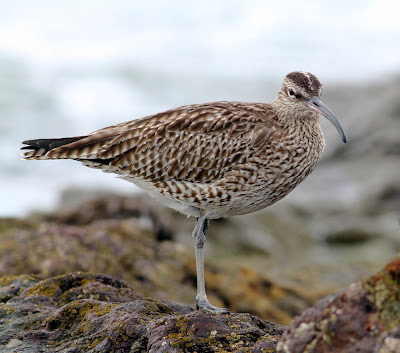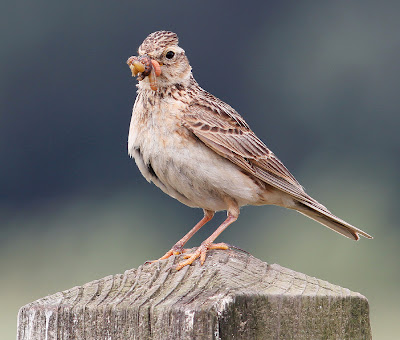Here’s an archived post from 31 January 2014 about the species gracing the blog header photo, the Curlew - Numenius arquata. There’s an interesting connection between a Curlew and John Lennon - read on.
==============================================================
After two weeks in the Lanzarote sunshine one of the long list of holiday emails awaiting response was one from the BTO. It concerned the recovery of a Curlew ringed a three and a half years before on 9th June 2010.
That morning Will and were in the hills above the market town of Garstang on the western edge of the Bowland hills, on the lookout for wader chicks to ring.
Curlew nest
We found a couple of broods of Curlew chicks that day and eventually tracked down one set of youngsters. This despite the frantic and determined efforts of the adult birds to see us off their home patch with their loud, shrieking and frantic calls.
Curlew
Curlew chicks
Ring number FC79566 was one of a brood of four healthy chicks ringed that day.
Fast forward to 13 January 2014; Liverpool John Lennon Airport alongside the estuary of the River Mersey, 7 kms southeast of Liverpool city centre and some 62 kms from Garstang.
Liverpool Airport and The Mersey Estuary
An airport worker conducting routine checks of the runways to ensure the safety of planes landing and taking off found the freshly dead corpse of FC79566. By now the bird would be an experienced adult that probably wintered each year in the same area.
Thankfully the worker had the good sense to report the finding to the BTO. This is where we came into the picture again with a little Internet digging and an opportunity to add more detail to the life history of FC79566.
I contacted the Operations Planner at the airport Andrew Hepworth who told me that the bird was probably hit by an aircraft but as no pilot reported a possible strike, the cause of death could not be confirmed. Andrew went on to say that due to their proximity to the Mersey estuary the time of year (winter) results in large numbers of Curlews close by. Groups of Curlews regularly fly over the aerodrome fence boundary and settle on the airfield. As a result the resident bird control operators constantly shift them back over the fence and toward to the shores of the estuary below.
Curlew
“As you appreciate we get our fair share of dead birds/strikes and these tend to be Curlew, Woodpigeon, gull species, Swifts during the summer, and the odd Kestrel."
In 2002 Liverpool Aiport was renamed in honour of John Lennon, a founding member of The Beatles, 22 years after Lennon's death in December 1980. A 7 ft tall bronze statue stands overlooking the check-in hall, and a tribute to the Beatle’s well known song Yellow Submarine graces the entrance to the airport.
Liverpool Airport
John Lennon
==============================================================
There's one thing for sure. I reckon I'll not be going to Liverpool or any other airport in the next few weeks or months.
There are still too few birds in the garden to catch. The Goldfinches have cleared away to breed elsewhere apart from a few local pairs that visit the garden.
There's Greenfinch in regular song, mostly in the next garden and in the dividing conifers a Woodpigeon sat on a nest with eggs.
Greenfinch
On Friday afternoon while sat in the sunshine I heard the familiar "tac,tac,tac", but no song of a Blackcap and then glimpsed one as it slipped through the ivy and hawthorn. I've not seen or heard one since but they do breed very close by each year.
Within our small close of six dwellings we have at least two pairs of Robins, Blackbirds, Dunnocks and Wrens. And the first House Martins are due soon. Always a welcome sight but more so this year.



















































































